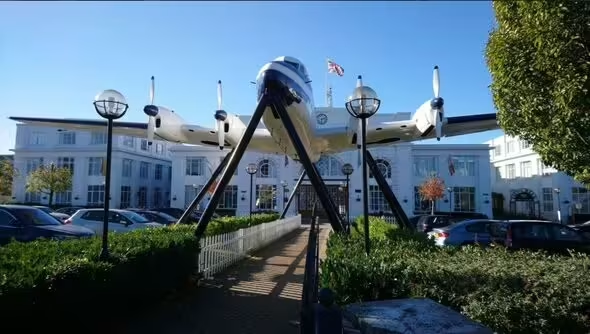London's forgotten aviation pioneer, Croydon Airport, remains a site of immense historical significance, but the question of its reopening is firmly grounded in reality.
London was once home to a truly groundbreaking airport, Croydon Airport, which, despite its pivotal role in aviation history, is largely unknown to many today. Between the 1920s and 1950s, this south London hub reigned supreme as the UK's main international airport, handling an unparalleled volume of passengers, cargo, and mail.
Croydon was a crucible of innovation, boasting a remarkable list of world firsts: the planet's first air traffic control tower, the inaugural airport terminal, and even the pioneering airport hotel. From its opening in 1920, it rapidly became Britain's aviation epicentre, serving as the base for Imperial Airways – the nation's first national airline. Flights to Paris and Berlin were regular occurrences, and the airport played a crucial role in shaping global air travel through the introduction of radio navigation and early air traffic control procedures. Perhaps most notably, the universally recognized "Mayday" distress call was developed here.
The airport's peak years were filled with legendary moments. In 1930, the intrepid Amy Johnson embarked on her record-breaking solo flight to Australia from Croydon's runways. Years earlier, Charles Lindbergh landed his "Spirit of St. Louis" after his historic non-stop transatlantic flight. Even Winston Churchill took early flying lessons here, famously surviving a crash. In a more dramatic turn, a flight from Croydon in 1936 transported General Francisco Franco to Spain, a pivotal event that ignited the Spanish Civil War. During World War II, Croydon served as a fighter airfield in the Battle of Britain, enduring heavy bombing in 1940.
However, Croydon's golden age was destined to end. By the late 1950s, the burgeoning demand for larger aircraft and longer runways made it increasingly difficult for the airport to compete. With no room for expansion within its increasingly urban surroundings, London Heathrow Airport swiftly took over as the capital's primary aviation gateway. The government's decision to close Croydon was made in 1952, and the final commercial flight departed in September 1959, marking the end of a remarkable era.
A Grounded Reality: The Chances of Reopening
For aviation enthusiasts and local residents, the dream of Croydon Airport's revival often surfaces. However, the stark reality is that a full commercial reopening is, for all intents and purposes, impossible.
The physical landscape of the former airport has been irrevocably transformed. Today, the vast majority of the site is occupied by residential developments, commercial properties, and vital road networks. The space that once accommodated runways and hangars is now densely built up, making any attempt to recreate airport infrastructure an undertaking of immense scale, requiring widespread demolition and unprecedented urban disruption. Such a project would be neither practically feasible nor financially viable.
Furthermore, London is now comprehensively served by a network of major international airports – Heathrow, Gatwick, Stansted, Luton, and London City Airport. These facilities collectively cater to the vast demands of modern air travel, possessing the extensive infrastructure, long runways, and vast operational areas that Croydon, with its limited original footprint, could never hope to match. Current plans for regional development, such as the proposed expansion of Gatwick Airport, further solidify the existing air travel infrastructure around London.
Preserving the Legacy: The Historic Croydon Airport Trust
While a commercial reopening remains a distant fantasy, Croydon Airport's rich legacy is meticulously preserved. The historic terminal building and the iconic control tower, now Grade II* listed landmarks (an upgrade from Grade II in 2017 to reflect their international importance), serve as a testament to its past. These buildings are home to the Croydon Airport Visitor Centre, a volunteer-led micro-museum that opened in 2000.
The Visitor Centre, operated by the Historic Croydon Airport Trust, offers a fascinating glimpse into Britain's first major airport. Visitors can explore interactive displays, examine exhibits, and even step inside the world's first air traffic control tower. Outside, a de Havilland Heron aircraft, painted to replicate the final passenger flight from Croydon, stands as a poignant symbol of the airport's bygone era.
The Visitor Centre is generally open on the first Sunday of every month, with guided tours providing an in-depth exploration of the building's history. It's advisable to pre-book tickets online through their website, as group sizes are limited. A small donation, typically £8 per adult, is requested to help with the ongoing maintenance of the archives and ensure the Visitor Centre remains open for future generations. Special events, such as the upcoming "Amy Johnson 95" anniversary celebrations in May 2025, which will include guided tours, children's workshops, and potentially a rare biplane flypast, are also organized throughout the year.
While the roar of aircraft engines no longer echoes across Croydon, the site continues to serve as a vital link to the dawn of commercial aviation, ensuring that its pioneering spirit is never truly forgotten.
_3.jpg)
_3.jpg)
_2.jpg)





.svg)

.jpg)
_1.jpg)
_2.jpg)